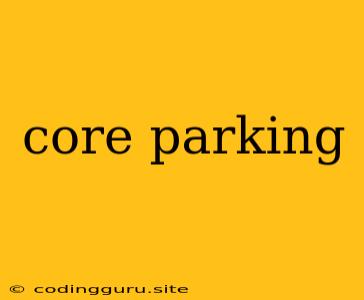Understanding Core Parking: Why It Matters and How to Manage It
Core parking is a feature found in modern operating systems, particularly in Windows and Linux distributions. It allows the system to disable or "park" specific processor cores to save power and potentially reduce heat generation. While this might sound beneficial at first glance, understanding when and how to manage core parking is crucial for optimal performance and system stability.
Why Does Core Parking Exist?
The primary reason for core parking is energy efficiency. In situations where the system is idle or under light load, running all processor cores at full capacity is wasteful. By parking certain cores, the system can reduce power consumption and heat output, extending battery life on laptops and reducing energy bills on desktops.
How Does Core Parking Work?
When a core is parked, it's essentially put into a low-power state. It doesn't completely shut down but remains available for use if needed. The operating system manages the process, dynamically parking and unparking cores based on system activity and predefined thresholds.
Potential Benefits of Core Parking:
- Reduced Power Consumption: This is the primary benefit, especially for mobile devices where battery life is crucial.
- Lower Heat Generation: Reduced power consumption leads to less heat, which can prolong the lifespan of components and improve overall system stability.
- Longer Battery Life: For laptops and mobile devices, this translates to longer usage times on a single charge.
Potential Drawbacks of Core Parking:
- Performance Degradation: While not always noticeable, parking cores can lead to performance bottlenecks in situations where the system is heavily loaded. This is especially true for tasks that require high processing power, such as gaming or demanding applications.
- Increased Latency: When a parked core needs to be activated, there's a slight delay in the process, which can cause stuttering or lag in demanding applications.
- System Instability: In some cases, improper core parking configuration can lead to system instability or crashes.
Managing Core Parking: Finding the Right Balance
The key to managing core parking is to find the right balance between power saving and performance. Here's how you can approach it:
- Understanding Your System: Assess your usage patterns and determine if power saving is a priority or if high performance is critical.
- Monitoring Core Activity: Use system monitoring tools to observe core usage. If you see consistent high utilization, consider disabling core parking for better performance.
- Adjusting Power Settings: Windows offers various power plans that control core parking settings. Experiment with different plans to find the optimal balance for your needs.
- Disabling Core Parking: If performance is a top priority, you can disable core parking completely in the operating system's power settings. This is not recommended unless you experience significant performance issues with core parking enabled.
Tips for Optimizing Core Parking:
- Use a Balanced Power Plan: Windows' "Balanced" power plan is typically a good starting point for most users, providing a decent balance between performance and power saving.
- Experiment with Power Plans: Don't be afraid to try out other power plans, such as "High Performance" or "Power Saver," to see which works best for your needs.
- Monitor System Performance: Pay close attention to your system's performance after making changes to core parking settings. If you notice any slowdown or instability, revert to the previous settings.
- Adjust Thresholds: Some operating systems allow you to adjust the thresholds for core parking, which can help fine-tune the behavior based on your specific needs.
Conclusion
Core parking is a double-edged sword. While it offers benefits in terms of energy efficiency and battery life, it can impact performance in demanding situations. By understanding the factors involved and adjusting settings appropriately, you can manage core parking to achieve the best balance for your individual needs and usage patterns. Ultimately, the goal is to strike a balance that minimizes power consumption without sacrificing essential performance for your critical tasks.
